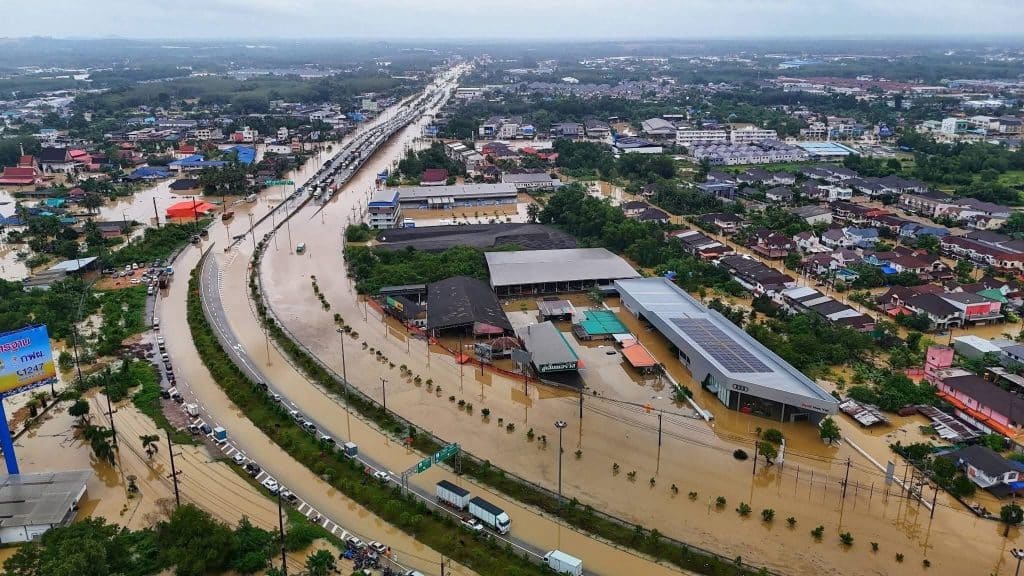Gentlemen’s Guide: Bangkok’s 5 Best Barber Shops
These top 5 barber shops in Bangkok are where gentlemen can elevate ...

Southern Thailand is currently enduring one of the worst flooding crises in decades, as relentless monsoon rains overwhelm the region. Between 19 and 21 November 2025, many areas recorded extraordinarily heavy rainfall, with accumulated amounts reaching up to 630 millimetres over three days.
In particular, Hat Yai, a major urban centre in the south, experienced 335 millimetres in a single day, its highest in three centuries. As a result, rivers and canals overflowed, drainage systems failed, and floodwaters inundated roads, homes and businesses. Water levels in some urban areas have risen between 0.5 and 2.5 metres.

The flooding has spread across at least ten southern provinces including Songkhla Province (where Hat Yai is located), Surat Thani, Nakhon Si Thammarat, Phatthalung, Trang, Satun, Pattani, Yala, and Narathiwat. Altogether, about 1.9 million people, or roughly 720,000 households, have been directly affected.
The economic fallout is already serious. Trade and tourism, both vital to the southern region, are estimated to be losing between 1 and 1.5 billion baht per day as businesses close and travel grinds to a halt.
In the city of Hat Yai and surrounding zones, many residents are stranded, properties are submerged, and essential transport routes remain impassable.
Despite the devastation, there are powerful stories of community resilience. In flooded towns, local authorities, rescue teams and volunteers have mobilised swiftly to evacuate children, elderly people and those most vulnerable, often using boats or high-clearance vehicles when roads became inaccessible.
Some hotels and foreign-visitor accommodations are submerged or unreachable, leaving travellers and workers trapped. In response, shelters and emergency centres have been set up, with aid flows including water pumps, relief supplies, clean drinking water and issuance of evacuation orders.
In provinces such as Songkhla, entire districts have been declared disaster zones; the local administration has commanded urgent evacuations to protect lives.
Meteorologists and water-management officials attribute the flooding to a powerful monsoon trough combined with a low-pressure cell over the Gulf of Thailand and lower southern region. These conditions led to extremely heavy rainfall in a short period, causing rivers and canals to overflow. This volume of rainfall, unprecedented in recent history, overwhelmed drainage systems and flood-mitigation infrastructure, revealing how vulnerable even supposedly protected urban areas are under shifting climate patterns.
In the immediate term the priority must be humanitarian aid: evacuations, rescue operations, food and clean water supply, medical care, and shelter for those displaced. Relief agencies, both governmental and community-based, must coordinate closely to reach remote or cut-off areas.
In a broader, longer-term view, this disaster is a stark reminder that climate volatility and extreme weather events are becoming more frequent. Southern Thailand, and all of Thailand, may need to re-imagine urban planning, drainage systems, flood defences, housing standards and disaster readiness.
It may also be time to re-evaluate seasonal patterns, early warning systems and community awareness, ensuring that both rural and urban communities can respond quickly when history-shaping weather events strike.
If you have plans to travel to the southern provinces, consider postponing until waters recede and officials confirm conditions are safe. Roads, ferries, airports and hotels remain affected.
If you wish to help: consider donating to trusted relief organisations, volunteering if possible, or supporting efforts to rebuild areas so they can better withstand or reduce the impact of future floods.
These top 5 barber shops in Bangkok are where gentlemen can elevate ...
Wandering around the globe, try out the signature tastes of cultures across ...
Sailorr and Molly Santana’s black grills fuse hip-hop swagger with homage to ...
Pets, as cherished members of our families, deserve rights and protections that ...
Meet Martin Constable, the Vietnam-based artist whose works are collected by icons ...
Through discarded monk robes and intimate storytelling, Eda Sriprom invites us to ...
Wee use cookies to deliver your best experience on our website. By using our website, you consent to our cookies in accordance with our cookies policy and privacy policy